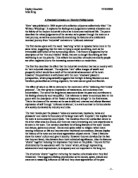The effect of nature on life is mirrored in the movement of the ‘widening river’s slow presence’. The river gives an impression of reassurance, and endurance over industrialism. The use of the lengthened assonance slows the pace and contributes to the feeling of security and tranquillity. This reference to water is continued later in the poem with the description of the ‘beach of shapes and shingle’ in the final stanza. This is the dream of the narrator as the sea is wild and untamed and allows liberated expression of self through ‘unfenced existence’, in a stark contrast to the boundaries of a society dominated by industry and rules.
The train travels past the pleasant ‘skies and scarecrows, haystacks, hares and pheasants’ and meets the boundary of the large town with ‘surprise’; this implies that the town is surrounded by countryside. The transition from the unshackled nature to the strict urban area is a shock, and there are many interesting and new experiences to be seen in the town. The narrator describes the striking features of the town ‘domes and statues, spires and cranes’. Domes and spires relate to religion which has a varying influence on life and has extensive traditional connotations. Statues display the history of the town and are show appreciation of past events. These 3 features show the towns’ culture and give it identity. However they are devalued by the fact that they are listed; this distracts from their individual significance. Also the features ‘cluster’ together reducing the impression they have on the public. They are further diminished by the association with the ‘crane’ which, although representing advancement and improvement, is temporary and not important in the long run.
The structures ‘cluster’ together mirroring the reaction of animals when they feel threatened. This suggests a feeling of protection as the domes, spires, statues and crane are a reassuring influence on life and they show appreciation of the past concurrently with development of the future. I feel this is a positive reference to development as the features cluster together to maintain mutual support. This shows that knowledge from the past can aid development. However the clustering of the objects could be perceived as negative as this could relate to claustrophobia within the town as the buildings compete for the limited space. This relates to a common natural occurrence; natural selection means that the animals which are successful in the competition for habitat will live while weaker animals die. This ‘survival of the fittest’ leads to improvement and adaptation in species. Similarly, the new and the old are competing to survive in the future. The feeling of claustrophobia is supported by the description of the ‘barge-crowded water’. The further reference to water shows how even the reliable ‘slow presence’ of the waterway is being choked by the increasing urbanization. The harsh aural qualities of ‘grain-scattered streets’ contribute to this idea of clumsy struggle and confusion. The town is portrayed as an erratic area where the buildings and features compete for the space and light, as well as the attention of the people which is necessary in order to gain importance in the future.
The inhabitants of the town are described in a harsh, negative way. Larkin is extremely insulting of their lifestyle, commenting stereotypically on their activities ‘stealing flat faced trolleys’. He assumes that because they live on the estates they are criminals. This unfair judgement is furthered with the derogatory description of their appearance ‘Cheap suits…sharp shoes’. The mention of ‘red kitchen-ware’ shows the cultural context of the poem as plastic brightly coloured equipment was popular at the time the poem was published.
However he seems to understand that the people are merely a by-product of their surroundings. He understands that the people come from ‘raw estates’; this suggests that they have the potential for success but lack the means.
In conclusion the poem ‘Here’ is about the initial judgements which are immediately made when the narrator views the town, and the gradual acknowledgement of the possibilities which lie underneath the overriding hardship. Furthermore there is also a message of the development of the world from the traditional ways to new modern concepts.







